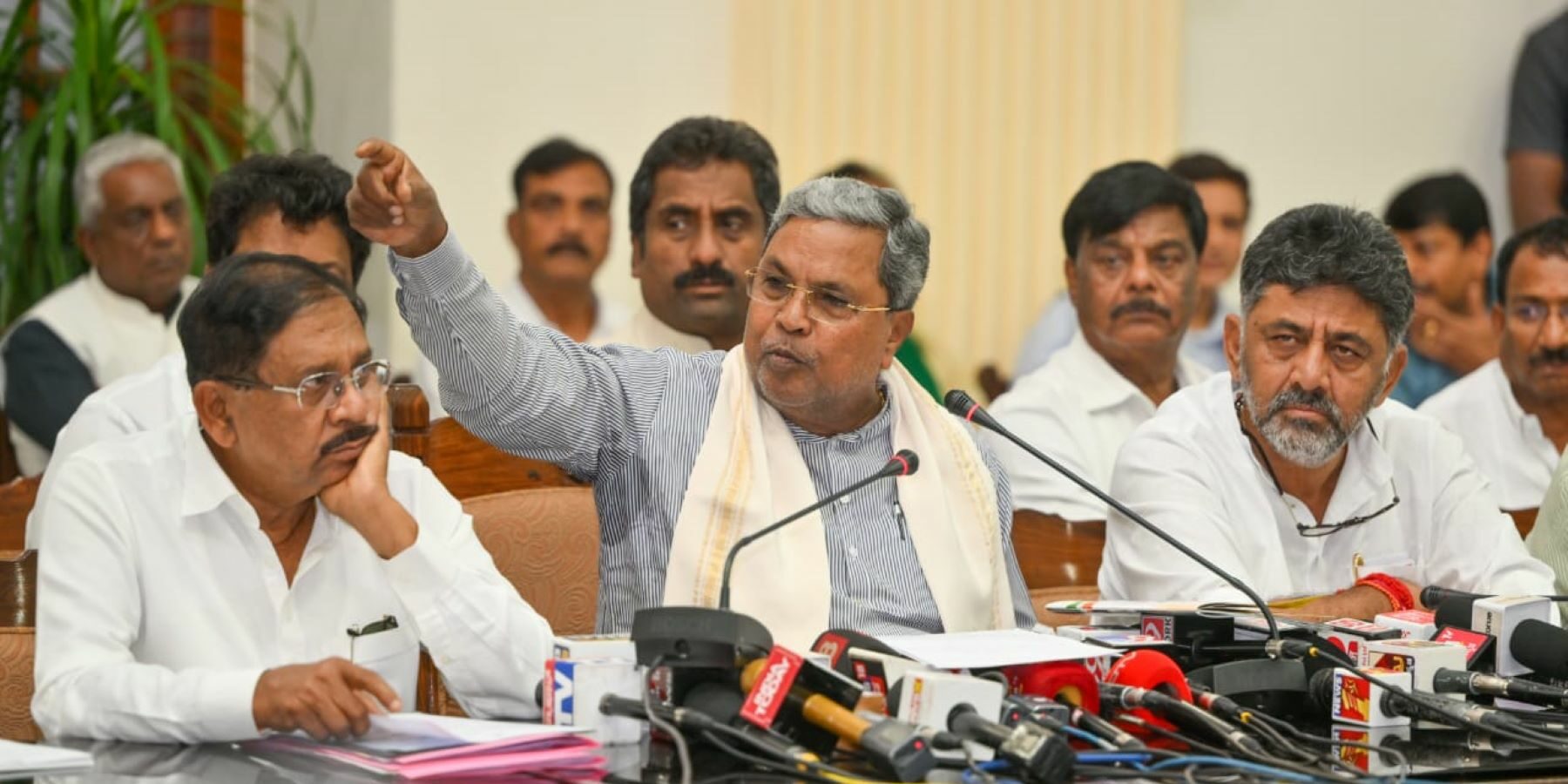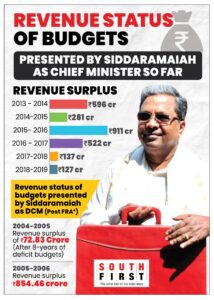For Siddaramaiah, who takes pride in his fiscal management skills, the 2023-2024 budget runs the risk of violating Karnataka Fiscal Responsibility Act.

Karnataka Chief Minister Siddaramaiah with DCM DK Shivakumar and Home Minister G Parameshwara announcing dates for five guarantees.
“We need to borrow on the basis of affordability and not on the basis of availability,” Siddaramaiah read out this line as finance minister and deputy chief minister while presenting the state budget for 2005-2006.
On 7 July, 2023, when he presents the FY 2023-2024 budget for Karnataka — the 14th budget speech of his political career — Siddaramaiah may have explored every possible “availability”, and not “affordability”, of borrowings, primarily to fund the Congress’ five election “guarantees”.
Successive governments in the state have showed immense commitment to adhering to the Karnataka Fiscal Responsibility Act (FRA) of 2002.
In recent times, with the exception of two years during the Covid-19 pandemic — FY 2021-2022 and FY 2022-2023 — Karnataka has always seen a revenue surplus budget — one of the three parameters laid down by the FRA.
Revenue surplus is when the state’s revenue receipts — from its own taxes, non-tax revenues, central grants and devolution from central taxes — exceed the state’s revenue expenditure in the form of committed expenditure which includes salaries, interest payments, pensions, subsidies, welfare schemes, etc.
As per the vote on account presented by former chief minister Basavaraj Bommai right before the Karnataka Assembly elections, the estimated revenue receipts for 2023-2024 was pegged at ₹2,25,910 crore (₹2.25 lakh crores).
Of this revenue receipt, Karnataka has committed expenditure — including existing subsidies, schemes, etc — of around ₹2,07,837 crore which makes up 92 percent of total revenue receipts. This leaves any government just eight percent — about ₹18,072 crores — from the revenue receipts for new schemes.
By Chief Minister Siddaramaiah’s own initial estimates, implementing the five guarantees could cost the exchequer between ₹50,000 crore and ₹52,000 crore annually. Revised estimates put the number at between ₹60,000 crore and ₹65,000 crores annually, but this is a work in progress.
Initial estimates suggested the Shakti scheme, which assures zero-ticket bus travel for women in government buses, could cost ₹4,050 crore while Anna Bhagya, intended to provide 10 kg of free rice to below-poverty-line and Antyodaya card holders every month, could cost ₹10,092 crore.
The estimated cost for the Yuva Nidhi unemployment stipend for youth is ₹1,274 crore while Gruha Jyothi — free electricity up to 200 units scheme — is estimated to cost ₹13,000 crore.
Congress’ big ticket guarantee, Gruha Lakshmi, which assures a ₹2,000 monthly basic income for women heads of households, is pegged to be the most expensive with an estimated cost of ₹39,000 crore.
The government is now looking at ways to narrow down the eligibility criteria for this scheme.
The numbers could also increase subject to challenges like the ones Karnataka is facing in buying rice for Anna Bhagya after Food Corporation of India (FCI) rescinded its decision to sell grain to Karnataka following a Union government order.
Since the guarantees are social welfare schemes, they are counted as revenue expenditure or committed expenditure. Here lies the challenge to FRA rules.
There simply isn’t enough revenue receipts for the Siddaramaiah government to fund these guarantees unless it takes measures to dramatically increase revenue by way of hiking taxes — perhaps excise, property and professional taxes — and/or mobilising tax collection by plugging leaks, increasing annual targets for different departments under the Revenue Ministry like commercial taxes, stamps and registration, transport or even sales tax on fuel. All such measures are sure to be met with criticisms.
If even the enhanced estimates for revenue receipts cannot cover the cost of revenue expenditure, Siddaramaiah may present his first ever revenue deficit budget as chief minister.
 Siddaramaiah takes great pride in his fiscal management abilities and has demanded the same from incumbent governments when he was in the opposition.
Siddaramaiah takes great pride in his fiscal management abilities and has demanded the same from incumbent governments when he was in the opposition.
To his credit, when Siddaramaiah presented his first budget (FY 2004-2005) after Karnataka enacted the FRA 2002, he presented a revenue surplus budget for the first time in eight years.
In every budget he has presented since the FRA was enacted in Karnataka, Siddaramaiah has adhered to parameters set by the Act, including always presenting a revenue surplus budget.
The 2023-2024 budget could very well be his toughest challenge yet.
The obvious way to fund the guarantees is additional borrowing — but borrowing for revenue expenditure is not sign of financial prudence and opens up a pandora’s box of mounting liabilities. Borrowings as Capital Receipts are ideally meant for Capital Expenditure for infrastructure building, creation of tangible asset etc.
Officials from various department have also suggested dropping of several existing but redundant schemes or subsuming of smaller schemes into larger umbrella schemes to move around funds.
Then there is the option of off-budget borrowings via infrastructure boards and development corporations from open market.
While it can be a short-term relief measure, such repeated off-budget borrowings via boards and corporations has cost Kerala heavily with the Union government slashing the state’s overall borrowing limit by nearly half this fiscal. Such is its result in Kerala, that the state government is struggling to even pay social security pensions.
As per the 2023-2024 vote on account document, Karnataka’s liabilities are expected to be ₹5,64,896 crore, which amounts to 24.20 percent of the state’s GSDP.
Under the FRA, the state’s liabilities cannot be more than 25 percent of GSDP. While the total liabilities also includes capital receipts (borrowings) announced by Bommai in his vote on account speech — which can be reallocated or rejected by the Siddaramaiah government — the state can only borrow an additional ₹18,674 crore before it violates FRA rules.
Unlike the Union government or several other states like Kerala or Andhra Pradesh that violate FRA rules year after year with revenue deficit budgets, borrowings beyond 25 percent of GDP/GSDP and fiscal deficit more than three percent of GDP/GSDP, Karnataka has had an impeccable record of healthy fiscal management.
For a man who was prematurely mocked over his financial understanding when he was gearing up to give his first budget speech, Siddaramaiah has often treated prudent fiscal management as a passion project.
Even as those around him point to several states and even Union government violating FRA rules with disdain, Siddaramaiah is looking to mop up resources while keeping the budget tightly within the FRA rules.
Despite all measures, the cost of the five guarantees — although only applicable for less than three quarters that are pending this particular fiscal — run the risk of violating FRA rules in what could be a first for Siddaramaiah as chief minister.

Apr 27, 2024

Apr 27, 2024

Apr 27, 2024

Apr 27, 2024

Apr 27, 2024

Apr 27, 2024